What makes this particular release stand out is its coloration, which contrasts starkly with the plainer pattern of the figure’s first release.
The 1990s were a stirring time for big theropod news: the crocodile-snouted spinosaur Suchomimus from Niger was described in 1998, new fragments of the now-(in)famous Spinosaurus itself were discovered in 1996 and 1998, and the gigantic Giganotosaurus was officially named in 1995. Another notable discovery was that of a new skull for Carcharodontosaurus, a similarly-sized relative of Giganotosaurus which was originally described around the same time as Spinosaurus (and whose original fossils met the same fate when the German museum housing them was bombed to bits in WWII – war sucks, doesn’t it?). Although not as prominent in pop culture as Giganotosaurus or Spinosaurus, the “jagged-toothed lizard” has maintained a presence in books and multimedia, including branches of the ever-popular Jurassic Park franchise. Mattel, who have been mining an impressive array of dinosaur genera for their extensive Jurassic World toy line, chose to add Carcharodontosaurus to their 2021 catalog of releases not once, but twice, with the first issue released around summertime, quickly followed by a dramatic repaint only a few months later. The initial release of this toy has already been well covered here on the Blog, but I found myself so taken by the repaint that I wanted to take a stab as well; so here we go!
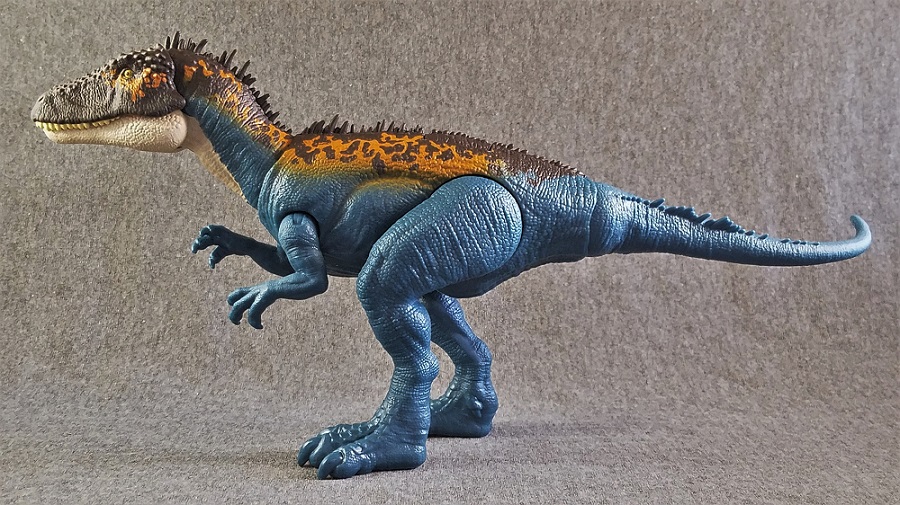
Mattel’s Carcharodontosaurus is released under the Dino Escape sub-line, with the additional Mega Destroyers moniker signifying the toy’s gimmick style. The figure measures about 37 cm (14.5 in) long – roughly 1:32 scale by real-world remains, but closer to 1:40 scale by Jurassic World Evolution game stats – and is packaged in an open box, with all body parts pre-attached. The dinosaur comes with restraint pieces that can be locked around the dinosaur’s head, only to be easily snapped off by activating the toy’s biting action gimmick via the button on the toy’s back. It’s an amusing gimmick that offers a little extra playability for kids. The biting action is fairly shallow, however, so trying to bite other dinosaur toys (or human toys) is less convenient. The neck and jaw are not locked, so they can be played with even without the button. Standard swivel-hinge joints are present in the shoulders and hips, with additional swivels in the ankles and a ball-socket joint in the tail.
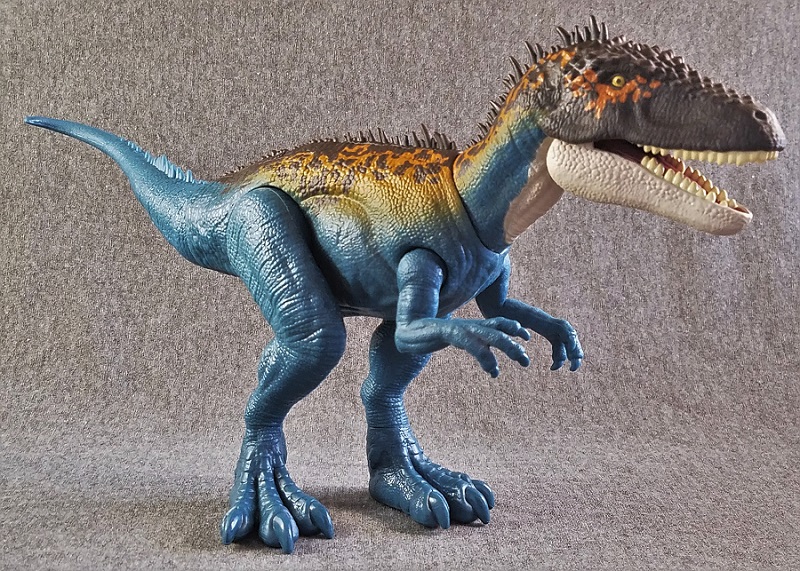
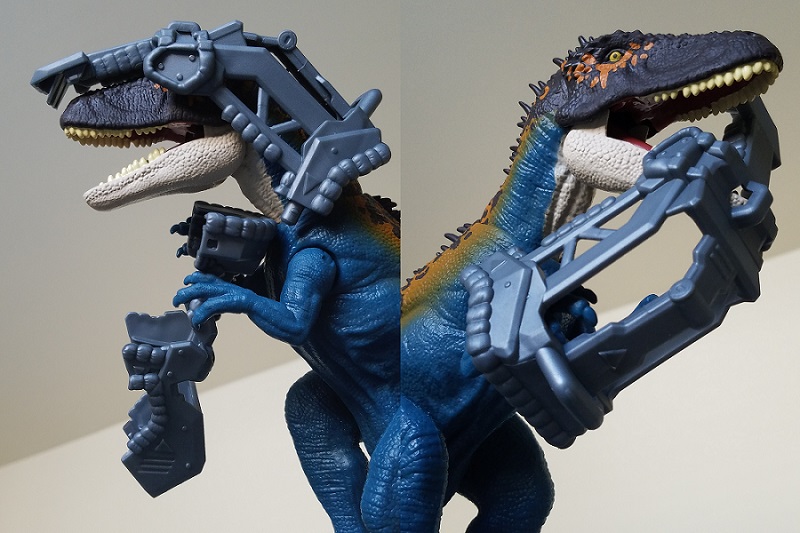
While the “mega-destroy” feature is the toy’s main gimmick, what makes this particular release stand out is its coloration. The first edition of the Carcharodontosaurus had a color scheme based on the animal’s model seen in the game Jurassic World: Evolution, this second release appears to take after a color scheme seen for the design seen in the earlier game Jurassic Park: Builder. The figure is predominantly painted a rich, deep blue, with a solid cream lower jaw and throat. A freckled pattern of orange and dark brown starts on the face of the figure and runs to the base of the tail; regrettably, unlike the figure’s first edition, the tail is left a solid blue with no further paint details. It’s an attractive and unique color scheme which contrasts starkly with the yellow grassland-striped pattern of the figure’s first release. This scheme is also a more speculative one: yellow and brown (plus red and orange) are commonly seen in modern-day large fauna, and have even been detected in select fossils of scales and feathers due to preserved melanosomes. Blue, in contrast, is a color which normally is not present as a pigment; thus it requires more complex integumentary structures that reflect the blue spectrum. To my knowledge, no preservation of these “structural colors” has been discovered in any fossilized dinosaur scales; whether this is evidence of absence or absence of evidence is difficult to say, however.
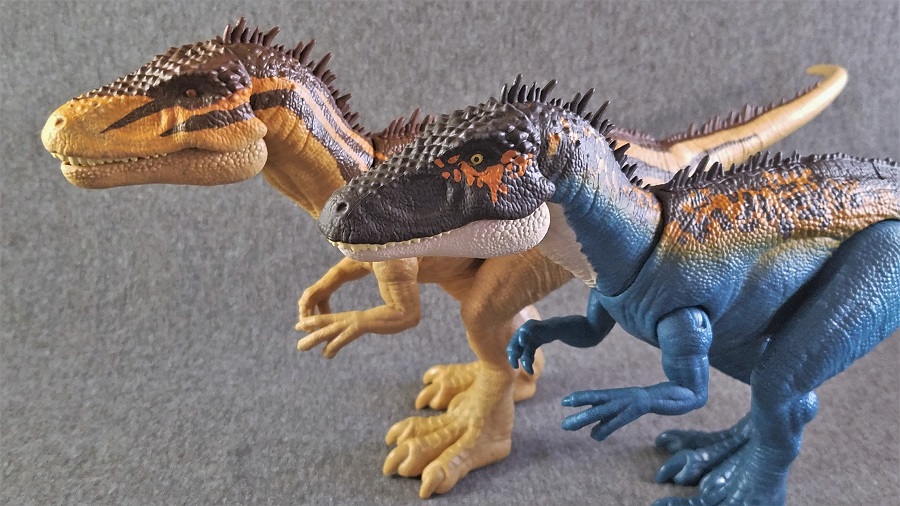
Mattel, of course, has produced plenty of brightly-colored dinosaur toys before, and most likely have not been concerned about scientific realism. The possibility of brightly-colored dinosaurs is intriguing, though. Since many modern-day reptiles and birds can see in color, dinosaurs may have been capable of the same; thus they may have been able to utilize a wider range of colors for camouflage and communication than large mammals are capable of today. One might envision this Carcharodontosaurus stalking the Saharan marshes and woodlands in the hours of twilight – its massive body melting into mere shadows amidst the trees, the last pinpricks of sunlight blending into the mottled patterns across the predator’s back. If only the Jurassic World films proper would be so experimental with their dinosaurs’ coloration!
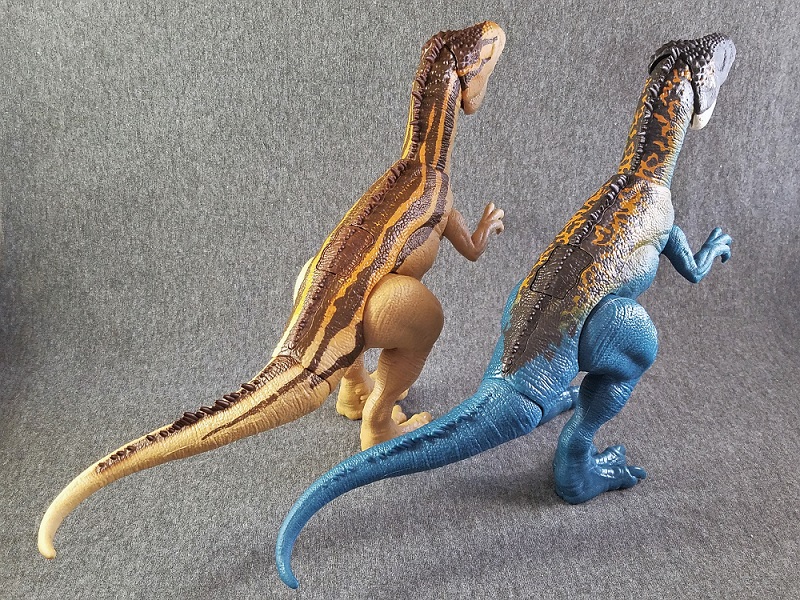
Apart from the color scheme, the Dino Escape Carcharodontosaurus is the same design as the first release. The general appearance of the toy matches the design for Carcharodontosaurus depicted in Jurassic World: Evolution: the body is slender and the legs are long*, with mid-sized arms and a roughly triangular head. The head on the toy, however, tapers less sharply than the in-game model; and the skull is much broader in dorsal view than either the game model or the real-life skull material (resulting in what almost looks like another callback to the Builder design). The toy does retain the rugose head ornamentation seen in the game, but the overall appearance of the head feels oddly softened and non-intimidating for a big predator hailing from the Jurassic franchise. Elsewhere on the body proportions are predictably stylized for toyetic appeal; surprisingly, the tail is less severely undersized than a lot of Mattel’s theropods, although an extra inch or two would still be an improvement. Scaly texture is consistent across the toy’s surface, and a single row of irregular quills along the spine give a little extra personality to the sculpt.
*Oddly, the right leg’s shin appears longer than the left, which is hard to un-see once noticed.

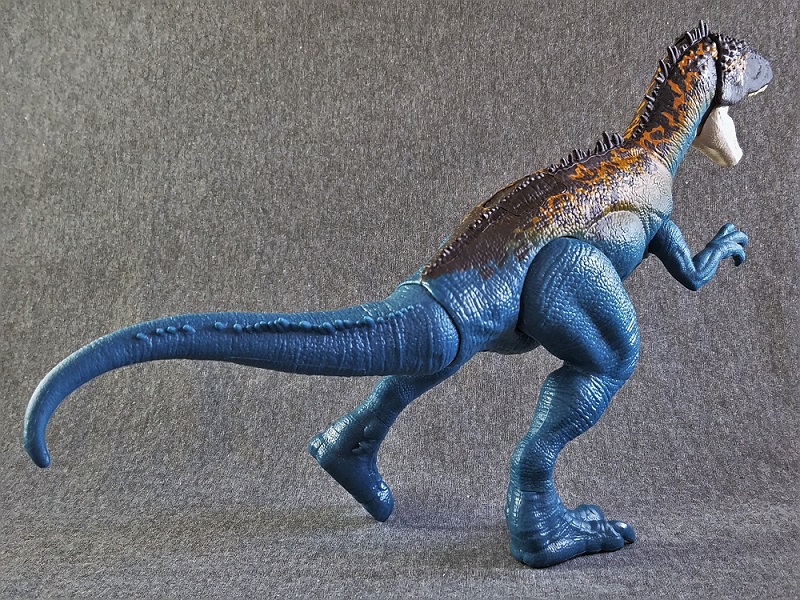
Although Carcharodontosaurus isn’t currently wanting for figures in the market – and, frankly, Mattel’s attempt at this genus is fairly weak, especially when compared to the splendid renditions by PNSO and GR Toys also released in the last year – the Dino Escape action figure is one of the more child-friendly options of this theropod to offer, and will compliment collectors’ Jurassic World displays nicely. This blue-and-orange reissue is my favorite of the two versions released, but they also display nicely together in case one has trouble choosing. You can find the figure fairly easily in stores or online through the Target store chain; Amazon and other web stores may likely carry it as well.
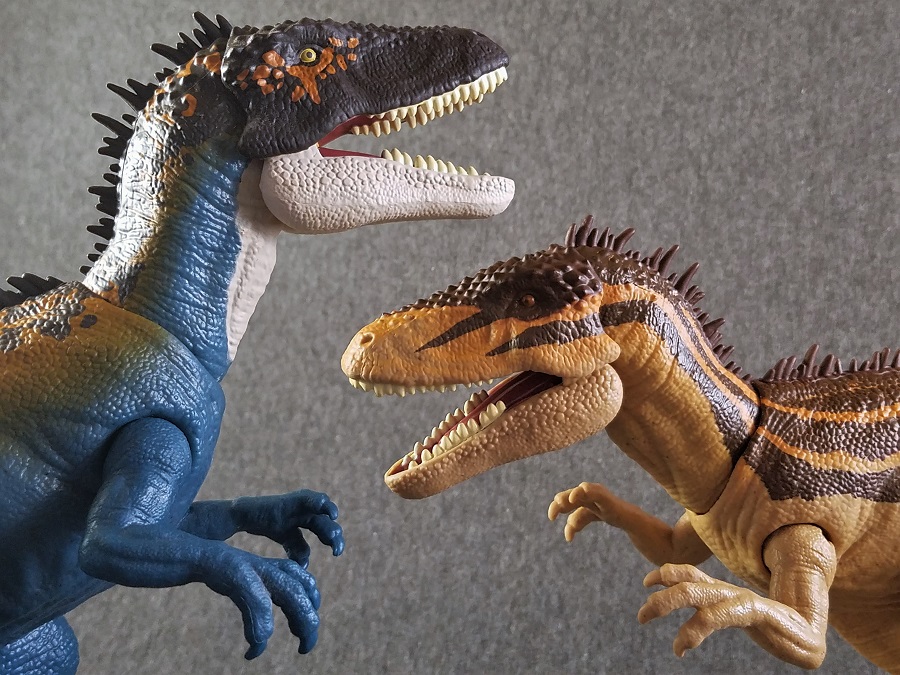
Disclaimer: links to Ebay and Amazon on the DinoToyBlog are affiliate links, so we make a small commission if you use them. Thanks for supporting us!




Pretty sure the colour scheme is a tribute to the Dino Showdown Allosaurus Assault (Jurassic Park 2009).
Much better colour scheme the second time around.
Setting accuracy aside, this looks like a really awesome action figure! I would have absolutely loved playing with this when I was little. Definitely one of the cooler JW sculpts. The color scheme reminds me a liiittle bit of the much loved JP Dino Showdown Allosaurus :’) I might be tempted to pick one up for fun if I see it in store! Great review!
This is definitely the superior color scheme of the two. All well. I do like that the original matches the game, that’s its saving grace.